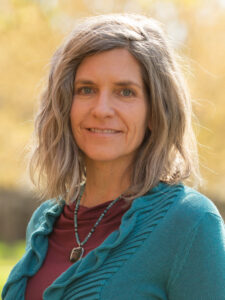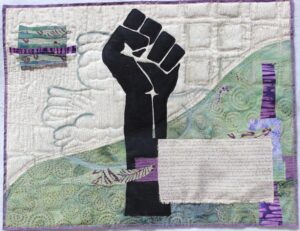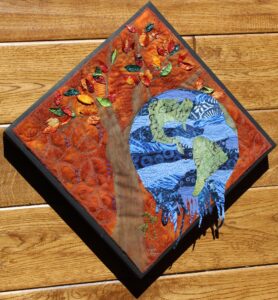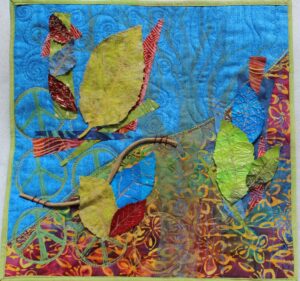Art for Change: Exploring your creativity
by Lisa Longacher, originally published by Mennonite Church USA

This post is part of the MennoCon23 #BeTransformed series. MennoCon23 will be held in Kansas City, Missouri, July 3-6.
Lisa Longacher loves building relationships as a development officer for Hesston College. She is an alumna of Hesston College and Eastern Mennonite University and is a member of First Mennonite Church of Denver (Colorado). Along with creating fiber art, she loves reading, running trails and spending time with her family.
______________________________
“Give peace a chance!” “Protect children, not guns!” “No human is Illegal!” When you think of changing the world, what does that look like? Have you ever marched for — or against — something that you are passionate about? I’ve done a little marching myself. In 1991, I joined tens of thousands of people in Washington, D.C., for a protest against the Gulf War. I was a college student, learning to express myself in new ways. I remember the rush of feeling part of something much bigger than myself. It took courage for me to chant along with those around me. As a cradle Mennonite who grew up in rural Kansas, I felt more comfortable joining in singing “All we are saying is give peace a chance” than I did with the shouting. My ancestors were discouraged from voting, in order to not conform to the world, and here I was, voicing my opinion publicly! It seemed like a big leap, but one I was interested in making. I got my inner hippie on, and it felt OK.
But are marches and protests the only way we can express ourselves? I’ve participated in a few marches since college, but for a variety of reasons, it’s not always accessible. Can I work for change simply by being creative?

As an art quilter, I’ve started to create pieces that I consider statements. While creating one of my first statement pieces in protest of racism, “No Justice, No Peace,” my son asked me what I was going to do with it. “I don’t know. I just need to do something,” I replied. Later, I read a call for entry for a juried exhibit, “In the Face of Hate, We Resist” at the Textile Center in Minneapolis, Minnesota. I entered the piece, it was accepted, and now, it hangs in a church in Minnesota. I hope that viewers can feel my anger and my hope. It may not change their mindset.
It may not even influence them to think about important social justice issues from a different perspective, but at the very least, it allows me to raise my voice against the injustice I see.
Another piece I created depicts the earth melting. I call it “Global Warming.” But not all statement pieces are so literal. Other works I’ve made in protest of climate change highlight “natural” leaves made of fabric alongside leaves made of potato chip bags, inspired by the trash we generated during the most locked down phase of the pandemic. Some art takes a bold stance, while other pieces are more subtle and may appear to be just something pretty to look at. Artists can quietly infuse ideas without shouting.

Creative expression takes many forms. I’ve been influenced greatly by authors, speakers and educators. Expressing myself through fiber art works for me. Writing a piece of music, penning a poem or capturing a perfect photograph works for others. Finding a way to tell your story to connect with others can be the most impactful way to cultivate change. The local art cooperative that I belong to has a program that teaches veterans who battle post-traumatic stress to use the healing qualities of art. The end product may be a statement piece, or it may be something beautiful to look at. Either way, the very act of painting the piece can be therapeutic.

Merely by being creative, these veterans have found a way to channel their pain in a positive way, to bring awareness to their suffering.
Numbers speak to those in charge. Joining gatherings of hundreds or thousands to march, cry out and carry signs can influence power shifts, just by showing up. But if a picture can paint a thousand words, what can you say with yours?

